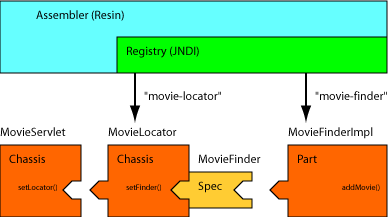
| Dependency Injection for Resources |
Documentation
Examples
Changes
Quercus
Database
Amber
EJB
SOA/ESB
IoC
JMS
Servlet
JMX
Hessian
Security
JAXB IoC
Basic Resource
Injection
Periodic Task
JNDI appconfig
| Basic Resource | Periodic Task |
The Dependency Injection pattern simplifies application code, and increases configuration flexibility by deferring component configuration and assembly to the container. Resin calls setters on the configured objects to assemble the resource dependencies.
Files in this tutorial
| WEB-INF/resin-web.xml | Configures the movie application |
| WEB-INF/classes/example/Movie.java | The movie bean. |
| WEB-INF/classes/example/MovieFinder.java | The MovieFinder interface |
| WEB-INF/classes/example/MovieFinderImpl.java | A MovieFinder implementation |
| WEB-INF/classes/example/MovieLister.java | The MovieLister to be configured with the finder implementation |
| WEB-INF/classes/example/MovieServlet.java | The MovieServlet to be configured with the finder implementation |
Dependency Injection
Dependency injection is a term used to describe a separation between the implementation of an object and the construction of an object it depends on, and the ability for a container like Resin to resolve the dependency.
Since the container instantiates and assembles the dependencies, the code is simpler and the configuration is more flexible. It's easy to substitute test implementations as the dependent resources, for example.
The MovieFinder example for this tutorial comes from Martin Fowler's Dependency Injection article.
More details on Resin's configuration is available at the bean-style configuration page.
Configuration as Assembly Line

The Dependency Injector pattern could also be called the Assembly pattern because it resembles an assembly line making cars.
- Parts are interchangable components like wheels. The parts might also be assembled like an engine in a car.
- Parts are attached to the Chassis like a car's frame receiving an engine.
- The Registry is holds partially-completed parts like a factory conveyor belt.
- The Assembler provides the Registry and assembles the Chassis and Parts into a completed resource.
Some important points:
- The application code (Chassis and Parts) is independent of the Assembler.
- Parts are interchangeable.
- The code needs to select an assembly pattern, e.g. Setter Injection.
Because the Assembler is independent of the code, a project could change the Assembler from Spring to Resin with no code changes. So using the Assembler/Dependency Injection pattern reduces dependencies on the framework. Only the configuration changes when changing Assemblers, not the code.
While testing, the test case or the harness plays the Assembler
role, simplifying the test suite and ensuring that the code under test
is the production code. A test can create a test implementation of
the Part, e.g. TestMovieFinder, for testing.
In some cases, the application code can provide its own
assemble() method for situations where the container is
incapabile of assembling the components. For example, the
MovieServlet could create an assemble()
method that grabbed the MovieLocator from JNDI.
Code for the Dependency Injection pattern
The only code specific to the setter-based injection pattern is the addition of a setter method for the dependent resource. In many application, that setter will already be written, so no additional code would be required.
Either an interface or a class can be used for the dependent resource, depending on the application's architecture. This example uses both: the MovieListener uses a dependent MovieFinder interface, and the MovieServlet uses the dependent MovieListener class.
public class MovieListener {
private MovieFinder _finder;
public void setMovieFinder(MovieFinder finder)
{
_finder = finder;
}
...
}
Configuration
<resource jndi-name="movie-finder"
type="example.MovieFinderImpl">
<init>
<movie director="Jackson" title="Fellowship of the Ring"/>
<movie director="Jackson" title="The Two Towers"/>
<movie director="Lucas" title="Star Wars"/>
<movie director="Gilliam" title="Brazil"/>
</init>
</resource>
<resource jndi-name="movie-lister"
type="example.MovieLister">
<init>
<movie-finder>\${jndi("movie-finder")}</movie-finder>
</init>
</resource>
JMX as a Registry
Resin can use JMX as the registry instead of JNDI. In this example, only the configuration needs to be changed. JMX uses the mbean-name instead of the jndi-name, and the jndi uses the "mbean:" schema.
<resource mbean-name="example:type=MovieFinder"
mbean-interface="example.MovieFinder"
type="example.MovieFinderImpl">
<init>
<movie director="Jackson" title="Fellowship of the Ring"/>
<movie director="Jackson" title="The Two Towers"/>
<movie director="Lucas" title="Star Wars"/>
</init>
</resource>
<resource jndi-name="movie-lister"
type="example.MovieLister">
<init>
<movie-finder>\${jndi("mbean:example:type=MovieFinder")}</movie-finder>
</init>
</resource>
Using JMX as the registry has some restrictions over JNDI. JMX requires an interface class. So the servlet's <movie-lister> setting can't be stored in JMX. JMX also can't support object references. All JMX getters and method values are value objects, never references. This limits the kinds of structures you can use easily with JMX.
Dependency Injection for Servlets
The Dependency Injection pattern is just as useful for servlet configuration as it is for resources. This example makes the MovieLister a parameter of the servlet. The resin-web.xml will configure the servlet with the appropriate MovieLister
The advantages of using dependency injection for the servlet are the same as for the resource:
- The servlet code becomes simpler.
- The servlet is no longer dependent on JNDI.
- The servlet is more easily testable by configuring it with test versions of the MovieListener.
<servlet servlet-name="movies"
type="example.MovieServlet">
<init>
<movie-lister>\${jndi("movie-lister")}</movie-lister>
</init>
</resource>
Compatibility
For compatibility, Servlets will generally add an
assemble() method to cover cases where the
container cannot assemble the Servlet. The
assemble() method will call JNDI with appropriate names
from the <init-param> values to assemble the dependencies.
See also
| Basic Resource | Periodic Task |
| Copyright © 1998-2006 Caucho Technology, Inc. All rights reserved. Resin ® is a registered trademark, and Quercustm, Ambertm, and Hessiantm are trademarks of Caucho Technology. |